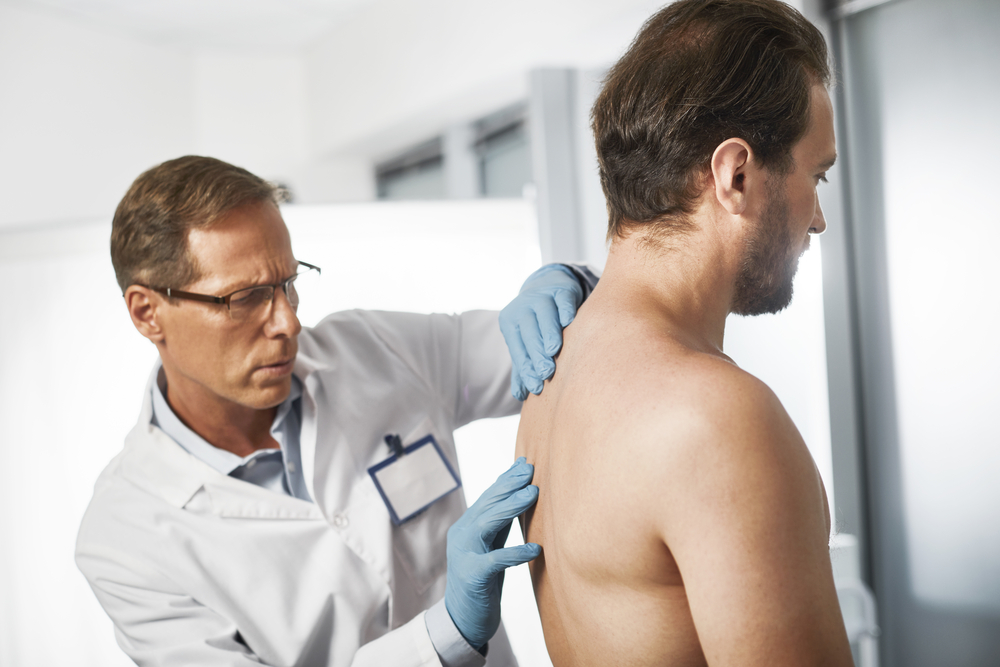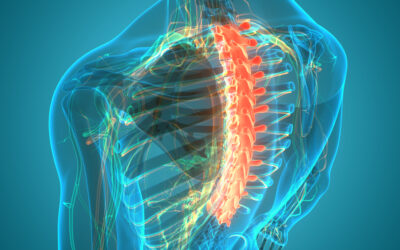
Upper back pain is a surprisingly common affliction, affecting up to one-quarter of the adult population at some point. While not as prevalent as lower back pain, discomfort in the thoracic region still accounts for a substantial slice of musculoskeletal complaints reported by patients. Pinpointing the root cause in each individual often requires some medical detective work, but several primary contributors typically emerge.
Understanding the complex anatomy of the upper back and being aware of high-risk situations makes it easier to prevent or address painful episodes down the road. This article will examine the various anatomical structures and pathologies capable of provoking discomfort between your neck and lower ribcage.
Anatomy of the Upper Back
The region technically called the thoracic spine spans from the first vertebra below the neck (T1) down to the bottom rib’s connection with the spine (T12). It consists of 12 total vertebrae stacked upon each other, cushioned by discs between each bone. The ribcage attaches to these vertebral bodies in the middle of the back.
A complex collection of muscles surrounds the bony architecture of the thoracic spine, making movement possible and providing physical support. Ligaments also connect bone-to-bone to enhance joint stability. Meanwhile, the spinal cord and nerve roots descend through vertebral column, carrying signals that influence sensation and motor control.
This intricate spinal anatomy allows for flexibility in most planes of motion while also guarding the vital nervous system. But the multitude of structures also provides many targets for potential dysfunction when injured or inflamed.
Musculoskeletal Causes of Upper Back Pain
Issues within the muscles, ligaments, joints or intervertebral discs represent the most prevalent sources of painful upper back symptoms. The mechanics required for posture and movement concentrate large forces upon these tissues. Like any other region of the body, exceeding structural limits results in inflammation and strain.
Poor Posture
Slouching forward or sustaining awkward positions for prolonged intervals tires out muscles required to hold the thoracic spine erect. As these supportive tissues stretch and weaken over time, tension across joints rises, concentrating weight unevenly.
The discs between each vertebra serve as the primary shock absorbers during movement or loading. Poor postural habits add pressure to one portion of discs, allowing uneven wear and tear to occur over months to years. Posture imbalance also alters ideal alignment, placing extra stress on the facets linking each vertebra.
Ultimately, the aberrant mechanics provoke ligament, muscle and joint irritation that manifests as localized discomfort. Studies clearly demonstrate that assuming neutral, balanced postures while sitting, standing and moving has a protective effect in preventing such strain to the upper back.
Overuse Injuries
Demanding too much of the upper back also takes a toll over time. Training errors among athletes such as swimmers, weightlifters or baseball pitchers frequently provoke inflammation. Occupations involving manual labor, prolonged vibration exposure or frequent heavy lifting combine to overload muscles.
Repetitive movements or constrained tasks across long periods fatigue tissues. Microtrauma accumulates until inflammatory chemicals flood the area, signaling pain. Even mild but repeated exacerbations eventually aggravate the upper back. Strict adherence to safe movement guidelines provides the best bet for prevention.
Traumatic Injury
Sudden trauma represents another route to precipitating upper back pain. The thoracic spine withstands very high loads thanks to thick paravertebral musculature and supportive ligament structure, yet overwhelming input still damages tissues.
Falls onto the back, harsh blows delivered to the spine during contact sports, and high-speed motor vehicle crashes commonly fracture vertebral segments. The force often tears ligamentous connections as well. Fractured ribs that attach to upper vertebrae also provoke severe discomfort due to continuity across these bones.
Seeking medical attention after major back trauma allows for optimal recovery even when pain seems minor initially. Some fractures become progressively worse over the subsequent days. Restoring appropriate alignment ensures proper healing.
Structural Origins
Degeneration of the discs, facet joints or vertebral bodies themselves promotes upper back pain because key stabilizing structures weaken. Spinal curves changing due to muscle imbalance also alter mechanics. Congenital abnormalities likewise set the stage for future symptomatic issues.
Herniated Discs
Also termed ruptured or slipped discs, this upper back trouble arises when the gel-filled nucleus pulposus at the center tears through the outer wall, contacting nerve roots or the spinal cord that normally never face exposure to disc contents. Cytokines and enzymes inside disc material incite inflammation upon reaching nerves, provoking muscle spasms alongside burning pain.
Spinal Abnormalities
Scoliosis represents an abnormal side-to-side spinal curvature in the coronal plane, while kyphosis denotes an excessive forward curve throughout the upper back itself, often called a “hunchback”. Lordosis describes similar disproportionate arching in the lower back. Other complex three-dimensional spinal deformities occur due to congenital malformations from birth or acquired influences like osteoporosis compression fractures across years.
Whatever the particular pattern, loss of optimal spinal alignment stresses the ligamentous support network and alters muscle firing timing. Discs and facet joints lose congruency, leading to premature breakdown. Eventual chronic discomfort patterns emerge. Only bracing or surgery remedy marked curvature anomalies.
Medical Causes of Upper Back Pain
Though apparently originating from the spine itself, certain systemic illnesses uniquely provoke upper back pain:
Infections
Rarely, bacteria access the vertebral bones or discs through the bloodstream, often entering after spine surgery or injection. Infection ignites severe inflammatory cascades near bone or nerves, generating intense localized back pain along with neurological symptoms like tingling or numbness. Fever accompanies advanced cases.
Joint Problems
Chronic inflammatory joint diseases like rheumatoid arthritis or seronegative spondyloarthropathies affect sites throughout the body, including the facet joints or costovertebral joints attaching ribs to spine. By products degrade bone and nearby discs. Spinal inflammation translates to aching and stiffness.
Myofascial Syndromes
Chronic upper back tension and tender muscular trigger points characterize syndromes like fibromyalgia. While debated whether originating from nerve roots or centrally, the outcome is activity-limiting pain. Psychosocial factors like anxiety and depression closely associate with such diffuse soft tissue pain sensitivity.
Referral Pain
Sometimes upper back pain actually originates from internal organs in the chest and abdomen. This happens due to a pain referral process. Nerves from inflamed organs can send signals that converge on the same areas of the spinal cord that receive pain signals from the upper back itself.
For example, inflammation around the gallbladder, pancreatitis flareups in the abdomen, or irritation in the lungs can all produce signals that the brain misinterprets as coming from the upper back. This crossover of nerve signals results in pain felt in the thoracic spine region even when issues with muscles or vertebrae are not the true culprit. Doctors refer to these instances as “referred pain” since organs away from the upper back refer their nerve signals to that anatomical area incorrectly.
Risk Factors Predisposing Upper Back Pain
Recognizing key risk factors provides opportunities to proactively avoid pain issues before they fully develop:
Age
Onset of upper back pain associates closely with age, peaking during middle years as opposed to those under 20 or over 60. Discs progressively desiccate and joints accumulate wear damage in a timeline aligned with reduced circulating anti-inflammatory factors. As the back’s structural shock absorbers decline across decades, even normal activity translates to pain.
Excess Bodyweight
The spine withstands large compressive loads. Obese individuals place far greater shearing and axial forces upon lumbar discs and facet joints with each movement compared to healthy-weight persons. Joint changes accelerate and pain often emerges. Losing excess fat benefits upper back wellness.
Tobacco Smoking
Chronic smokers exhibit earlier disc degeneration and heightened spine arthritis rates versus the general population. Coughing increases intradiscal pressures. Smoking also constricts blood vessels that normally nourish discs through small capillary beds. Reducing or avoiding tobacco use benefits long-term back health.
Occupation Hazards
Jobs involving repetitive heavy lifting, continual whole-body vibrations or static hunched postures provoke more frequent and severe spinal disability claims compared to clerical work. Jobs in construction, professional driving, and nursing apply the most strain to the back and represent the highest risk vocations for back injury.
Poor Physical Conditioning
Lacking proper muscular endurance and joint range of motion throughout the thoracic area leaves one vulnerable to strains, sprains or poor healing after insults. Simple overexertion readily overpowers deficient tissue resilience. Dedicated efforts toward flexibility and strength-building provide protection.
Conclusion
As the complex anatomy and biomechanics of the upper back demonstrate, the causes of upper back pain are often multifaceted and complex. Accurately identifying the contributing factors for a patient’s discomfort requires piecing together several clues, including imaging results, risk factor profiles, and evaluation of any recent changes that could have impacted the back.
In some straightforward cases, the cause is obvious – like a trauma fracture or severe infection. But other times, the cause is more subtle, like chronic poor posture that gradually stresses the spine over time until pain eventually emerges. And in a few instances, no clear-cut mechanical cause is found, even after extensive testing. Still, major lifestyle or occupational strain to the back is usually a contributor in these ambiguous cases.
Regardless of the exact trigger, an accurate diagnosis allows for treatments targeted at the specific tissues and pain-generating mechanisms. While complex, the intricate nature of spine anatomy actually lends itself well to skilled manual and movement-based therapies when the inflammation source is precisely identified through careful diagnosis. So despite initial complexity, customized treatment can make a big difference by addressing the mechanical roots of each patient’s upper back pain.
Written by Dr. Tony Mork
Orthopedic Spine Surgeon
I’m Dr. Tony Mork, MD, a Minimally Invasive Orthopedic Spine Surgery Specialist in Newport Beach, California. With over 40 years of experience, I’m dedicated to providing information for all topics that involve neck and back pain.
February 12, 2024
Contact a Spine Specialist Near You!
Related Articles
Lower Back Pain | An Overview
Lower back pain is an exceedingly common affliction that affects up to 80% of adults at some point in their lives. Understanding the underlying causes of lower back pain is key to finding the appropriate treatment and relief. Anatomy of the Lower Back The lower back,...
Degenerative Disc Disease | Causes and Risk Factors
Degenerative disc disease describes age-related wear and tear to the rubbery spinal discs cushioning the vertebrae that can lead to chronic back or neck pain. While partly genetic, there are also lifestyle factors and injuries that accelerate disc degeneration over...
Upper (Thoracic) Back Pain | Understanding Why it Hurts
Upper back pain refers to any type of discomfort or pain in the thoracic spine region. This article will provide an in-depth overview of upper back pain, including its causes, symptoms, diagnosis, and treatment options. We aim to help readers understand the anatomy of...



